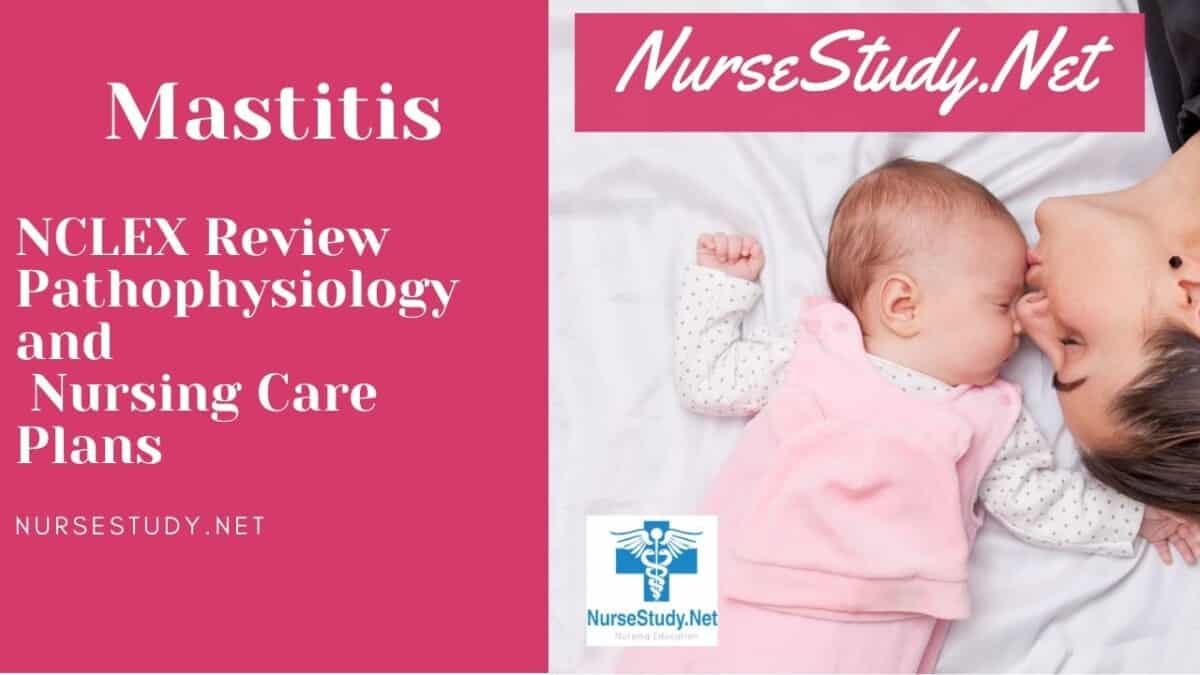Mastitis is an inflammatory condition of the breast tissue typically occurring during breastfeeding. This nursing diagnosis focuses on identifying symptoms, managing pain and inflammation, preventing complications, and supporting successful breastfeeding.
Causes (Related to)
Mastitis can develop due to various factors affecting breast tissue health and lactation:
- Milk stasis or blocked milk ducts
- Bacterial infection (most commonly Staphylococcus aureus)
- Improper breastfeeding technique
- Predisposing factors such as:
- Cracked or damaged nipples
- Previous history of mastitis
- Oversupply of breast milk
- Maternal fatigue
- Contributing conditions including:
- Poor breast drainage
- Missed feedings
- Tight clothing or bras
- Compromised immune system
Signs and Symptoms (As evidenced by)
Mastitis presents distinctive signs and symptoms that nurses must recognize for proper diagnosis and treatment.
Subjective: (Patient reports)
- Breast pain and tenderness
- Burning sensation while breastfeeding
- Fatigue and malaise
- Flu-like symptoms
- Headache
- Decreased milk output
- Difficulty breastfeeding
Objective: (Nurse assesses)
- Breast inflammation and redness
- Increased breast temperature
- Swelling and hardness
- Fever (>101°F/38.3°C)
- Enlarged lymph nodes
- Decreased range of motion
- Signs of abscess formation
Expected Outcomes
The following outcomes indicate successful management of mastitis:
- The patient will report decreased breast pain within 24-48 hours
- The patient will maintain successful breastfeeding
- The patient will demonstrate proper breastfeeding technique
- The patient will remain free from complications
- The patient will show signs of healing within 5-7 days
- The patient will verbalize understanding of preventive measures
Nursing Assessment
Monitor Vital Signs
- Check temperature every 4 hours
- Assess pain levels
- Monitor for systemic symptoms
- Document cardiovascular status
Assess Breast Tissue
- Evaluate affected area
- Document size and extent of inflammation
- Check for abscess formation
- Monitor skin integrity
- Assess milk flow
Evaluate Breastfeeding
- Observe feeding technique
- Assess latch and positioning
- Monitor feeding duration
- Document the frequency of feeds
- Evaluate milk transfer
Check for Complications
- Monitor for abscess development
- Assess for systemic infection
- Watch for sepsis signs
- Document healing progress
- Evaluate treatment response
Review Risk Factors
- Assess breastfeeding history
- Document previous mastitis
- Note anatomical challenges
- Review lifestyle factors
- Check support systems
Nursing Care Plans
Nursing Care Plan 1: Acute Pain
Nursing Diagnosis Statement:
Acute Pain related to inflammatory process of breast tissue as evidenced by verbal reports of breast pain, guarding behavior, and facial grimacing during breastfeeding.
Related Factors:
- Inflammatory response
- Tissue swelling
- Milk stasis
- Bacterial infection
Nursing Interventions and Rationales:
- Assess pain characteristics and intensity
Rationale: Establishes baseline and monitors treatment effectiveness - Apply warm compresses before feeding
Rationale: Promotes milk flow and reduces discomfort - Administer prescribed pain medication
Rationale: Manages pain and inflammation
Desired Outcomes:
- The patient will report decreased pain levels
- The patient will demonstrate comfortable breastfeeding
- The patient will maintain adequate rest periods
Nursing Care Plan 2: Ineffective Breastfeeding
Nursing Diagnosis Statement:
Ineffective Breastfeeding related to breast inflammation and pain as evidenced by interrupted feeding patterns and inadequate milk transfer.
Related Factors:
- Breast engorgement
- Improper positioning
- Maternal anxiety
- Pain during feeding
Nursing Interventions and Rationales:
- Teach proper breastfeeding techniques
Rationale: Ensures effective milk transfer - Demonstrate correct positioning
Rationale: Reduces nipple trauma and improves comfort - Encourage frequent feeding
Rationale: Prevents milk stasis
Desired Outcomes:
- The patient will demonstrate proper breastfeeding techniques.
- The infant will show adequate weight gain
- The patient will report a successful milk transfer
Nursing Care Plan 3: Hyperthermia
Nursing Diagnosis Statement:
Hyperthermia related to inflammatory response to infection as evidenced by elevated temperature and flu-like symptoms.
Related Factors:
- Bacterial infection
- Inflammatory process
- Systemic response
- Tissue inflammation
Nursing Interventions and Rationales:
- Monitor temperature regularly
Rationale: Tracks infection progression - Administer antipyretics as ordered
Rationale: Reduces fever and discomfort - Encourage adequate fluid intake
Rationale: Prevents dehydration
Desired Outcomes:
- Temperature will return to the normal range
- The patient will maintain adequate hydration
- The patient will report improved comfort
Nursing Care Plan 4: Risk for Impaired Skin Integrity
Nursing Diagnosis Statement:
Risk for Impaired Skin Integrity related to breast inflammation and potential abscess formation as evidenced by tissue redness and swelling.
Related Factors:
- Inflammatory process
- Tissue edema
- Bacterial infection
- Mechanical trauma
Nursing Interventions and Rationales:
- Assess skin condition regularly
Rationale: Enables early detection of complications - Maintain proper hygiene
Rationale: Prevents secondary infection - Monitor for signs of abscess
Rationale: Enables prompt intervention
Desired Outcomes:
- The patient will maintain skin integrity
- The patient will demonstrate proper breast care
- The patient will remain free from complications
Nursing Care Plan 5: Anxiety
Nursing Diagnosis Statement:
Anxiety related to breastfeeding difficulties and mastitis symptoms as evidenced by expressed concerns and increased tension.
Related Factors:
- Pain and discomfort
- Feeding challenges
- Fear of complications
- Knowledge deficit
Nursing Interventions and Rationales:
- Provide emotional support
Rationale: Reduces anxiety and builds confidence - Education about condition
Rationale: Increases understanding and control - Connect with support resources
Rationale: Establishes ongoing assistance
Desired Outcomes:
- The patient will report decreased anxiety
- The patient will verbalize coping strategies
- The patient will demonstrate confidence in the management
References
- Blackmon MM, Nguyen H, Mukherji P. Acute Mastitis. [Updated 2023 Jul 21]. In: StatPearls [Internet]. Treasure Island (FL): StatPearls Publishing; 2024 Jan-. Available from: https://www.ncbi.nlm.nih.gov/books/NBK557782/
- Olsen CG, Gordon RE Jr. Breast disorders in nursing mothers. Am Fam Physician. 1990 May;41(5):1509-16. PMID: 2333828.
- Rench MA, Baker CJ. Group B streptococcal breast abscess in a mother and mastitis in her infant. Obstet Gynecol. 1989 May;73(5 Pt 2):875-7. PMID: 2649829.
- Spencer JP. Management of mastitis in breastfeeding women. Am Fam Physician. 2008 Sep 15;78(6):727-31. PMID: 18819238.
